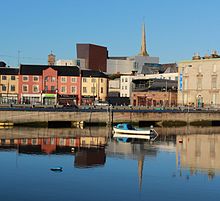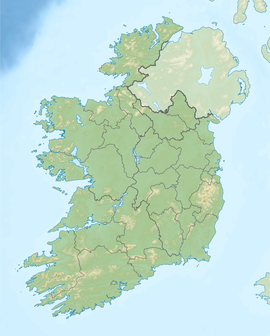Sack of Wexford
| Siege of Wexford | |||||||
|---|---|---|---|---|---|---|---|
| Part of theCromwellian conquest of Ireland | |||||||
 Wexford waterfront | |||||||
| |||||||
| Belligerents | |||||||
|
|
| ||||||
| Commanders and leaders | |||||||
|
|
| ||||||
| Strength | |||||||
| 3,500 - 4,000 | c. 6,000 | ||||||
| Casualties and losses | |||||||
|
1,500 - 2,000 killed (including civilians) 3,000 captured |
c. 20 killed Unknown wounded, or died of disease | ||||||
TheSack of Wexfordtook place from 2 to 11 October 1649, during theCromwellian conquest of Ireland,part of the 1641–1653Irish Confederate Wars.English Commonwealthforces underOliver Cromwellstormed the town after negotiations broke down, killing most of theIrish ConfederateandRoyalistgarrison. Many civilians also died, either during the sack, or drowned attempting to escape across theRiver Slaney.
Background
[edit]On 17 January 1649, theCatholic Confederationsigned a treaty with theDuke of Ormond,Royalistleader inIreland.[a]Following theExecution of Charles Ion 30 January, they were joined byUlster Protestantswho objected to his killing, and replacement of the monarchy by theCommonwealth of England.[b]However, their defection caused a split with Ulster CatholicEoghan Ó Néill,whose troops were some of the most effective in the Confederate army, and who now made a separate truce withMichael Jones,Commonwealth governor ofDublin.[3]
Seeking to secure Ireland as a base for the new king,Charles II,Ormondbesieged Dublinin June, but was weakened by having to divert resources against Ó Néill. On 2 August, Jones defeated him atRathmines,a victory that allowed 12,000 mostly veteranNew Model Armytroops underOliver Cromwellto land near Dublin unimpeded. At a Council of War held atDroghedaon 27 August, Ormond and his commanders agreed to avoid open battle, but instead strongly hold key ports along the east coast. The garrisons were ordered to delay their opponents as long as possible, relying on hunger and disease to weaken them as winter approached.[4]
This policy, while reasonable in itself, failed to take into account the large, modern, artillery train that accompanied Cromwell. These guns were too powerful for Drogheda's fortifications, whichwas besiegedon 3 September, and the walls quickly breached. When surrender negotiations broke down, the town was stormed on 11 September, and many of the garrison of 2,600 were killed. Despite being within the then-accepted rules of war,[c]this act was unprecedented for the Wars of the Three Kingdoms, and Cromwell later admitted it was intended to deter future resistance.[5]
Cromwell returned to Dublin, while Ormond retreated to the Confederate capital,Kilkenny.Sending a detachment against Ó Néill, who was negotiating a return to the Confederacy, Cromwell and his main force advanced onWexford.This port was an important base for Confederateprivateerattacks on English merchant ships, and provided a link with the exiled Royalist court inFrance.His army moved far quicker than Ormond anticipated since their supplies and siege artillery were transported by a naval squadron underRichard Deane.[6]
Ormond despatched 1,000 men underDavid Synnotto garrison Wexford, with his field army based atNew Rossto protect its supply lines. Cromwell's force of around 6,000 arrived outside the town on 2 October; two days later, a detachment led by Jones surprised the Royalist garrison of nearbyRosslare,giving Deane a secure harbour.[7]
Siege
[edit]
On arrival, Cromwell offered the garrison terms, which allowed them to leave without their weapons, and guaranteed the town would remain unharmed. Although acceptable to the civilian leadership, they were rejected by Synnot, who sought to delay as agreed at Drogheda. The rains had started, and many of the besiegers were already suffering fromdysentery.[7]
While waiting for Deane to land his artillery, Cromwell continued to negotiate with Synnott, who was reinforced by 1,500 men from Viscount Iveagh's regiment on 5 October.[d]Ormond had planned to relieve Wexford himself, but was diverted toYoughalwhen its Protestant Royalist garrison defected. However, he sent Synnott another 600 men, led by ColonelEdward Butler.[9]
The guns opened fire early on 11 October, concentrating on the castle, which was held by a separate garrison, under Captain Nicholas Stafford.[e]Synnot now accepted the original terms, but when his delegation met with Cromwell, they made new demands. These included guarantees of religious freedom, with the garrison retaining their weapons, and the privateers currently in harbour allowed to leave with their goods and ships intact. Cromwell deemed them unacceptable and now lost patience.[11][f]
The artillery breached the castle walls in two places, and Stafford surrendered when Cromwell's infantry began forming for an assault. He failed to inform Synnot and Butler, who were taken by surprise, allowing Commonwealth troops from the castle to break into the town. In the sack that followed, between 1,500 and 2,000 soldiers and civilians died, over 300 of whom drowned escaping across the river. Up to another 3,000 were taken prisoner, for the loss of only 20 attackers.[13]
In his report to London, Cromwell suggested this was retribution for the killing of Protestants earlier in the rebellion, although he regretted the damage prevented him from using Wexford for winter quarters.[14]His personal responsibility is still a matter of debate; historians includingTom Reilly,Nicholas Canny,and Roger Hainsworth, suggest the assault was launched without his approval, and he was unable to control his troops once the plundering began.[15]
The war in Ireland was characterised by brutality on both sides; between 2,000 and 3,000 Scots and Ulster Presbyterians died in the pursuit that followed O'Neill's victory atBenburbin June 1646.[16]Although the killings at Drogheda and Wexford were on a larger scale, Irish Catholics captured in England and Scotland, or taken at sea, were routinely executed throughout the war, includingPhiliphaughin 1645, andDunavertyin 1647. For various reasons, attitudes had noticeably hardened since the end of theFirst English Civil Warin 1646. Royalist officers captured in the 1648Second English Civil Warwere often shot, and enlisted men transported to theWest Indies.[17]
Aftermath
[edit]The loss of Wexford ended any chance ofCharles IIlanding in Ireland; the Royalist fleet, commanded byPrince Rupert,now broke out ofKinsaleand headed forLisbon.It also eliminated the use of the port by privateers; the Parliamentarians claimed to have captured over 80, plus 100 fishing boats.[18]
Detaching so many troops to strengthen the garrison, who were then killed, captured or deserted, left Ormond fewer than 3,000 men, although this later increased to 7,000 by early November. Cromwell captured New Ross, then moved ontobesiege Waterford,before being forced to retreat by sickness and lack of supplies. Between October and November, his army suffered over 1,000 deaths from disease, including senior officers such as Michael Jones andThomas Horton.[19]
Despite this, the 1649 campaign was far more successful than anticipated, and seriously weakened the Royalist/Confederate alliance, composed as it was of factions with little in common. Religion generally prevailed over other motivations; in October, Protestant Royalists inCorkchanged sides, followed byLord Inchiquin,and the rest ofMunster.In Ulster, Ó Néill's army remained on the sidelines until negotiations with Ormond were completed on 20 October; he died two weeks later, on 6 November. At the start of September, onlyDerrywas held by those loyal to the government in London; by mid-December, they controlled the entire province, apart fromEnniskillen.[20]
Notes
[edit]- ^'Royalist' forces contained IrishProtestantmembers of theChurch of Ireland,a small number of IrishCatholicslikeClanricardewhose loyalty to the Crown superseded religion, and English exiles, mainly Protestant, but including Catholics likeArthur Aston.[1]
- ^Many Ulster Protestants wereCalvinistScots immigrants, who viewed monarchy as divinely ordained; while they had little liking for Charles the man, the execution of a king was considered sacrilegious[2]
- ^If a town refused to surrender when a "practical breach" was made in the fortifications, it was subject to being plundered by the besiegers, and the garrison took their chances. However, executing them in such numbers was highly unusual
- ^Arthur Magennis, 3rd Viscount Iveagh, (1623-1684), had formerly served with Ó Néill's Ulster Catholic army, but remained loyal to Ormond, and was one of the last to surrender in 1653.[8]
- ^The Staffords were a large and important family in County Wexford; a Captain Nicholas Stafford was elected MP forFethardin the1689 Jacobite Parliament.[10]
- ^His final letter to Sinnott on 11 October 1649 reads as follows; "Sir, I have had the patience to peruse your propositions; to which I might have returned an answer with some disdain. But to be short I shall give the soldiers and non-commissioned officers quarter for life and leave to go to their several habitations......and as for the inhabitants, I shall engage myself that no violence shall be offered to their goods, and that I shall protect their town from plunder."[12]
References
[edit]- ^Robertson 2014,p. 122.
- ^Macleod 2009,pp. 5–19 passim.
- ^Finnegan 2014.
- ^Royle 2004,p. 526.
- ^Royle 2004,pp. 530–531.
- ^Murphy 2011,pp. 20–23.
- ^abPlant 2008.
- ^Lenihan, Padraig."Magennis, Arthur".Dictionary of Irish Biography.Retrieved16 July2023.
- ^MJ 1875,pp. 225–226.
- ^D'Alton 1844,p. 572.
- ^Mitchell 2004,p. 150.
- ^"Letters: Cromwell's negotiations with Wexford".Wexford Hub.15 May 2015.Retrieved31 May2020.
- ^Mitchell 2004,pp. 150–151.
- ^Royle 2004,pp. 534–535.
- ^Mitchell 2004,p. 151.
- ^Hayes-McCoy 1989,p. 194.
- ^Royle 2004,pp. 454–455.
- ^Faul 2004,pp. 297–298.
- ^Royle 2004,p. 537.
- ^Royle 2004,p. 536.
Sources
[edit]- D'Alton, John (1844).Illustrations, Historical and Genealogical: Of King James's Irish Army List (1689)(2108 ed.). Franklin Classics.ISBN978-0342516131.
- Faul, Denis (2004). "Cromwell in Ireland; the massacres".Seanchas Ardmhacha: Journal of the Armagh Diocesan Historical Society.20(1): 293–298.JSTOR25746993.
- Finnegan, David (2014)."The Irish Catholic clergy, Stuart sovereignty and the 1650 appeal to the Duke of Lorraine".Revue électronique d'études sur le monde anglophone.11(4).doi:10.4000/erea.3734.
- Hayes-McCoy, Gerard Anthony(1989).Irish Battles: A Military History of Ireland.The Appletree Press.ISBN978-0862812126.
- "Letters: Cromwell's negotiations with Wexford".Wexford Hub.15 May 2015.Retrieved31 May2020.
- Macleod, Donald(Autumn 2009)."The influence of Calvinism on politics"(PDF).Theology in Scotland.XVI(2).
- Mitchell, Neil (2004).Agents of Atrocity: Leadership, Political Violence and Human Rights.Palgrave Macmillan.ISBN978-1403962744.
- MJ (1875). "Cromwell in Ireland. III. Expedition to Wexford".The Irish Monthly.3:218–228.JSTOR20501601.
- Murphy, Elaine (2011). "Pirates in our channel; the Cromwellian navy in Ireland, 1649 to 1653".History Ireland.19(4).JSTOR41231661.
- Plant, David (9 February 2008)."The Siege of Wexford, 1649".BCW Project.Retrieved27 May2020.
- Robertson, Barry (2014).Royalists at War in Scotland and Ireland, 1638–1650.Ashgate.ISBN978-1409457473.
- Royle, Trevor (2004).Civil War: The Wars of the Three Kingdoms 1638–1660(2006 ed.). Abacus.ISBN978-0-349-11564-1.
Bibliography
[edit]- Fraser, Antonia (1975).Cromwell Our Chief of Men.Panther, St Albans.
- Lenihan, Padraig (2001).Confederate Catholics at War.Cork: Cork University Press.ISBN1-85918-244-5.
- Ohlmeyer, Jane (1998). Ohlmeyer, Jane; Kenyon, John (eds.).The Civil Wars.Oxford.
{{cite book}}:CS1 maint: location missing publisher (link) - Reilly, Tom (1999).Cromwell: an honourable enemy.Brandon: Dingle.ISBN0-86322-250-1.
- Wheeler, James Scott (1999).Cromwell in Ireland.Dublin: Gill & Macmillan.ISBN0-7171-2884-9.

